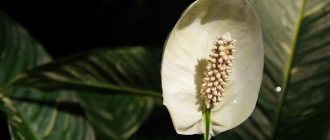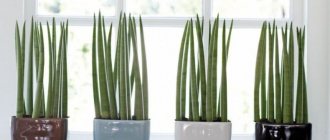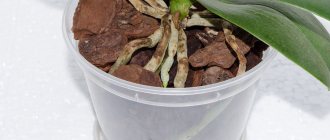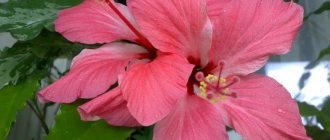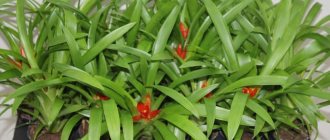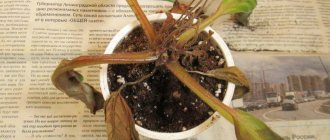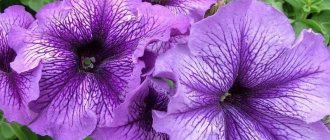The importance of pruning for indoor rhododendron
For this plant, pruning is simply extremely important. This is not only from an aesthetic point of view, first of all it is necessary for its proper growth and flowering. If Rhododendron is not trimmed on time, the flower will have too much green mass , which, in turn, will prevent the appearance of new flower buds. If the pruning period is long, then be prepared that your favorite plant will turn into an ordinary shrub.
In order for the plant to bear fruit, it must be pruned after each flowering.
Why do you need to prune Azaleas?
Without pruning, Azalea will lose its decorative appearance over time, begin to look untidy, and flowering will become increasingly sparse.
Regular pruning of the plant has several purposes:
- Crown formation. It can be given a certain shape - spherical, conical, cylindrical or arched, without allowing the branches of the plant to grow chaotically.
- Removing inflorescences after flowering. At the same time, dry shoots and most of the green mass that grew during budding and flowering are pruned.
- Thinning the crown to prevent the development of diseases and pests. Too thick foliage prevents the access of light and fresh air inside the bush, leading to waterlogging in some areas.
- Preparing for winter. It consists of removing too long shoots and young branches located next to the flower buds.
When is this necessary and is it possible after flowering?
Azaleas need to be pruned first after flowering .
Often this period occurs in early spring. If you begin to notice that for some reason the plant has withered leaves or twigs, cut them off immediately. You should not prune during the early flowering period, when the buds are just beginning to form, as there is a risk of hurting them. Monitor the density of the leaves and, if necessary, adjust them by releasing new shoots. Visually, after all the pruning manipulations, your bush should have an even, rounded shape.
Why do problems arise?
Next we will look at why, in a city apartment, an azalea can sometimes dry out or shed its leaves and how to help the plant. This happens for various reasons and the solutions to problems are also different.
Dries
As a rule, azalea dries out due to the proximity of radiators , which dry out the air very much. To protect it from this scourge, you need to make a screen of plastic film, which will be used to separate the plant from the battery:
- We attach a wide (the width of the radiator or window sill) piece of polyethylene to the curtain.
- We place the lower edge of the polyethylene between the battery and the wall. This way all the hot air will go into the room.
Another way to protect the plant from drying out is to regularly, every 2-3 days, spray its leaves with cool water.
Some gardeners use an interesting way to increase humidity in the area where azaleas are installed.:
- Water is poured into the pan.
- Place any non-absorbent stand in the water (you can use caps from plastic bottles) so that it is slightly above the water.
- Place a pot with an azalea on a stand, but the bottom of the pot will not come into contact with water and the roots will not rot.
Drops leaves
There are several reasons why an azalea might lose its leaves. Most of them lie in improper flower care:
- Transfer immediately after moving to a new place . To avoid this problem, buy an azalea in winter, and replant it before flowering, and always in a larger pot (read about when azalea blooms, for how long, why it doesn’t open buds, and about why indoor azalea doesn’t bloom and what to do to make the plant produce buds is described here). When transplanting, it is important to maintain the integrity of the earthen coma.
- Insufficient soil moisture - if the plant has dried out, you need to put it in a larger container with water for 20-30 minutes so that the soil is properly saturated with moisture. This procedure is repeated several times.
- Dry air in the room - it is necessary to humidify the air using the measures described in the previous paragraph.
- Unsuitable soil acidity - Since the plant likes acidic soil, it is better to grow it in special soil for azaleas, which is sold at garden centers. You can also water the flower with water infused with acidic high-moor peat.
- The appearance of pests - for example, if the leaves are covered with dark spots or a sticky coating - this means that the azalea has been attacked by a scale insect. The flower is isolated from other house plants and treated with insecticides (for example, Aktellik or Aktara).
- Excessive watering and root rotting - it is important to provide the plant with good drainage even when planting. To do this, add expanded clay to the bottom of the pot in a layer of 2–3 cm.
You need to carefully observe the flower and, if the tips of the leaves begin to dry out (which means that the azalea is preparing to shed its leaves), immediately analyze the situation and take the necessary measures.
If the flower has dried up, you first need to cut off all the shoots to living tissue , and then improve the conditions for the azalea to stay in your home.
Azalea is one of the most beautiful home and garden flowers. And, like any beauty, she is quite capricious, requiring increased attention and careful care both during flowering and during the dormant period. If all the requirements are met, at the beginning of spring, when other flowers are still dormant, you will be able to admire the large bright azalea flowers.
How many times a year should the procedure be performed?
This process can be done more than three times a year, provided that you did everything correctly. Namely, we thinned out the density, after the flowers have faded, then the next steps can begin at the end of summer. Observe, if the shoots have grown by more than 5 cm, then do not wait, but immediately take the scissors and get rid of the excess length.
Don't overdo it. Netto, instead of helping “Your green friend” renew itself and reveal a new color, he may simply get sick. Be careful and check the length of the shoots and the color of the leaves .
What to do next with rhododendron?
After the azalea has bloomed, it can be replanted. For this procedure you will need:
- large container with clean water at room temperature;
- sterile pruning shears or scissors treated with alcohol;
- ready-made soil for azaleas with the required acidity;
- expanded clay for drainage.
The pot for replanting should be taken a size larger than the old one.
Then proceed like this:
- 2–3 cm of expanded clay is poured into the bottom of the pot.
- They squeeze the pot with the azalea with their hands to make it easier to pull it out, and take out the flower with a lump of earth.
- Place the plant in a container of water and keep it there for 30 minutes to an hour, so that approximately 1/3 of the soil is separated from the roots.
- Inspect the roots, if there are rotten ones, cut them off with pruners or scissors.
- Place the azalea in a larger pot and fill it with soil to the previous level.
- Water with zircon solution for better rooting.
Algorithm of actions at home
In order for the flower renewal to be done according to all the rules, it is important to know what tasks you face. If you are simply going to thin out the Azalea, then you need to use one tool, but if you fundamentally get rid of the roots, then a completely different approach is required. In this case, everything is individual; the main thing is to correctly analyze the state of the flower. At the same time, any pruning begins with the choice of tool.
Preparing tools
If Rhododendron only needs superficial cleaning, that is, getting rid of dried leaves, then you can use ordinary scissors.
When pinching and shortening shoots, which occurs just at the time of flowering in the summer, you will need pruning shears. Since work must be done quickly, the tool must be well sharpened and hygienically clean.
The main thing is that the tools are clean and moderately sharpened. You shouldn’t “saw” them; with this type of care, just smoothly walk through the necessary places.
Choosing a cutting location
The cut must be made correctly, otherwise you may not wait for new flowering buds. The main task when cutting is to ensure that the plant can reproduce again.
The cut must be made at such an angle that the Azalea shoots grow outward, not inside the crown. By the way, this rule exists for almost all “green” households.
Treatment
If necessary, treat the choice of cut location with charcoal. Or, replace charcoal with Ranet paste.
For those who are interested in whether it is possible to prune at the root, we will answer that in this way it is worth shortening only those shoots that are denser and grow extremely upward. The remaining shoots are cut to 5 cm. Do not forget to create a visually correct plant shape .
How to care for a plant in a pot when it has bloomed?
In order for the plant to safely spend the dormant period and emerge from it stronger and rested, it is important to properly care for it. The following explains what to do with a faded flower and how to preserve it.
Do I need to trim?
Pruning of faded azaleas is necessary. Procedure:
- First - all the branches on which the flowers have faded, up to a height of 3-4 leaves. You don’t need to trim, but pick off the dried inflorescences.
- Next - all the weak and thin branches to thin out the thickened crown (at the same time you can form the azalea crown of the desired shape).
Some time after the leaves fall, young shoots begin to grow. They must be pinched to prevent them from bushing.
The plant is pruned only with sterile pruning shears; the cut site is also treated with RanNet disinfectant paste, which will help the cut heal faster and provide protection from infection.
Temperature
Providing the required temperature depends on the time of year:
- In summer , immediately after flowering, azaleas are kept in a shady place in the garden at a temperature no higher than +20 °C.
- In autumn (from October to December) the lowest temperature is needed (+7–11 °C) - this can be achieved by placing the plant on an insulated loggia.
- At the beginning of winter, it is best to keep azalea at a temperature no higher than +10 °C. In urban conditions, this temperature can be achieved on an insulated loggia, and if there is none, then near the balcony door.
Humidity
The humidity in the room where the azalea overwinters should be at least 70% . Since apartments are usually much drier in winter, you can place an air humidifier next to the flower, and also spray it with a spray bottle every two to three days.
You should not place a pot of azalea near a hot radiator.
Lighting
Wintering azaleas need a minimal amount of light . Since the required temperature can usually be provided close to the windows, to create partial shade you will have to cover these windows with some materials that poorly transmit light - sheets of thick paper, newspapers, etc.
Watering
It is necessary to water the azalea rarely during the dormant period. It is better to take settled water, ideally melt water (in winter this is not a problem). It should be cold, but not icy (15–16 °C). Since azalea loves high acidity, citric acid is added to the water (several crystals per 1 liter).
The frequency of watering depends on the room temperature: as soon as the surface of the soil in the pot is dry, it is necessary to water the flower.
Top dressing
Despite the fact that after flowering there is a period of rest, azaleas need fertilizer. They will give the flower the opportunity to enter a new flowering stronger and healthier.
Always fertilize the azalea after watering so that the earthen ball is moist.
After flowering, the azalea is fed with special liquid fertilizers:
- Garden of Miracles (dilute 8–10 ml of solution in a liter of water, water at the root once a month).
- Azalea (dilute 8-10 ml in 1 liter of water, water at the root once every 3-4 weeks).
The main principle of fertilizing azaleas during the dormant period is a high nitrogen content. It promotes good recovery of plants after flowering and their active growing season in the future.
Photo
In the photo you can see the plant after pruning.
Possible errors and their consequences
Listed below are possible mistakes when pruning rhododendrons.
- Too late summer pruning. Pruning branches in the second half of summer is fraught with the risk of triggering increased growth of shoots from the buds that the plant has established for the next year. In this case, the bush may even bloom before winter. Young shoots will not have time to prepare, develop dense bark and acquire winter hardiness.
- Excessive pruning throughout the season can have the same consequences. The shoots have dormant buds that remain dormant for many years. Excessive pruning can cause them to awaken, and the bush will quickly begin to age and complete its full development cycle with possible death. To avoid negative consequences and death of the bush, it is necessary to adhere to the rule of moderation in pruning branches.
- In addition, you should try to trim above the buds, making neat cuts. If you make cuts high above the buds, then part of the shoot dies, and the bushes take on an unkempt appearance.
- To collect seeds, only strong ovaries are selected. They are left, and dried perianths and parts of flowers are manually removed around them. If it is necessary to carry out targeted pollination, then put gauze bags on the flowers to avoid accidental pollination by neighboring bushes. Flowers are pollinated manually with pollen from selected forms. This is a very interesting activity, although you will have to wait a long time for the results. It takes 4-5 years for a new plant grown from a pollinated seed to bloom.
For your information! There is no need to be afraid of pruning rhododendrons. This will make the bushes take on an even more aesthetic appearance, and the entire area will look impressive and will noticeably add value.
Basic mistakes
- The first and most common mistake is failure to comply with the time interval for pruning the plant . Azalea is a rather whimsical “green”; if you rush or overexpose it, it will be difficult for it to bloom.
- The second mistake is neglecting the tool, or lack thereof . Often housewives, having noticed a dried leaf, try to get rid of it using improvised means. And often they pull it out by the roots with bare hands. This is strictly prohibited.
- The third mistake is ignorance of the basic rules of care after circumcision . The cut areas must be carefully processed.
What fertilizer to use for rhododendrons
The ornamental crop does not place high demands on soils, since there are no highly fertile areas in its natural habitat. But you can’t leave it completely without fertilizers. Indicators that it is time to fertilize are slower growth, a decrease in the number of buds, and pale color of foliage and flowers. If yellow spots appear on the leaves, their surface becomes brown, becomes thinner and tears, this indicates a lack of nitrogen and potassium; if the leaf turns red, this indicates a lack of phosphorus.
In the spring, ammonium nitrate at a rate of 30-40 g per 1 m² of tree trunk circle is effective for high-quality care of rhododendron and activation of growth processes. After flowering and pruning of the ovaries, feed in the form of the mineral fertilizer azofoska in a dose of 20-30 g per 1 m². In August, superphosphate (15-20 g) and chlorine-free potassium fertilizer potassium sulfate are needed - 15-20 g per 1 m².
First care after the procedure
Post-procedure care is simple. After treating all cut areas, it is necessary to give the plant a day to “heal the wounds,” otherwise, with the first watering of the Azalea, rotting may begin (how should it be watered and what are the consequences of incorrect actions?). After this, carefully water the leaves using a spray bottle. The water should be clean and if you use tap water, then let it sit for 2 hours.
It is best to use melted, slightly cool water after pruning. This way the flower will quickly “come to life”.
Thus, it is necessary to strictly follow the rules of care for this plant. It requires attention, so watch it grow. Do not neglect the instructions, otherwise, instead of beautiful buds, you may end up with dried out ikebana.
In this case, it is worth monitoring the external condition of the plant. Since this flower does not tolerate warm places well, after pruning it is best to move it to a dark, cool room. There the flower can quickly “come to its senses” and delight you for many years to come.
The main thing to remember is that weak and diseased shoots are cut off first , since they have the most negative effect on the practical growth and reproduction of the flower. Then start shaping the appearance of the plant.
Read about the intricacies of caring for azaleas at home after purchase here.
For azaleas, it is very important to create the right environmental conditions. You can read about them in our articles; we also recommend that you familiarize yourself with the application of fertilizers.
Conditions for growing garden azaleas
Garden azalea is a perennial plant with fairly slow growth. This should be taken into account when choosing a place to plant a plant and organizing care for a young bush. Azaleas bloom for the first time only 3–4 years after planting, maturing and reaching full development.
The ideal temperature for growing garden azaleas in summer is 20–25 °C, which is quite acceptable for most areas of central Russia. In winter, many varieties and hybrids can withstand frosts down to 27–32 °C.
And yet the plant needs protection and year-round support. When planning to plant a garden azalea, you need to be very careful in choosing a suitable location. In nature, rhododendrons are light-loving, but when exposed to direct sunlight:
- lose their decorative effect faster;
- flower buds form worse;
- shorten the flowering period.
Therefore, for an azalea it is better to find a flat area in partial shade, protected from the wind and flooding by spring waters, where the bush will not suffer from summer heat, frost and gusts of cold air. A northern, eastern or western wall is suitable for planting shrubs near the house.
Rhododendrons grow well next to larger trees. However, it is worth taking into account that the roots of the plants do not interfere with each other. Spruces with a tap root system, small-leaved lindens and oaks feel good next to garden azaleas.
Azaleas benefit from proximity to garden and park ponds. Here, thanks to natural air humidification, the plant blooms longer and its foliage remains fresh.
